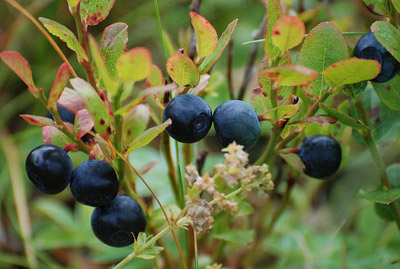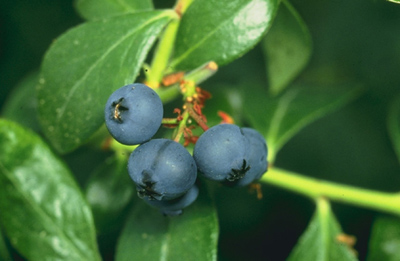How to Grow Blueberries

Learning how to grow blueberries is simple and they can provide a unique addition to our diet. Are there any other blue fruits? The incredibly high level of antioxidants in each blueberry makes it an essential fruit for longevity. This is why the northwest natives lived to become wise elders. The wild blueberries and huckleberries were a staple food for them. The B vitamins boost metabolism. The minerals in each berry aid in moderating heart rate and blood pressure.
Just like the unique role the berries play in our bodies, the
bushes that blueberries grow upon fill a unique ecosystem niche. In the wild, blueberries and their huckleberry
relatives grow on forest edges where they receive a lot of sunlight. In learning how to grow blueberries, we have to understand that different species grow at different altitudes
and therefore ripen at different times of the summer and early fall. And so the blueberry (and huckleberry) is
essential to the survival of many wildlife species, especially the beloved
black bear.
Be More Prepared For Your Next Outdoor Adventure!

Don't leave home without knowing these six essential survival skills. Our free survival mini guide reveals the strategies of:
- Shelter & fire to prevent the number one cause of death
- Obtaining clean water to avoid life-threatening dehydration
- Common wild survival foods and other critical skills!

How can we apply these observations of blueberry bushes in nature to our farm and garden ecosystems?
We know from studying the wild relatives that they thrive in very moist, acidic soil conditions (4-5.5 pH). They grow on edges where they receive a good amount of sunlight. They are enjoyed by animals.
These observations guide us in our blueberry patch decision making processes. We place our patch in a moist, yet still well drained place that receives a lot of sunlight, possibly along the southern edge of our orchard or forest garden. We plant the plants in the fall or spring, when temperatures are mild and root growth is peaking. We plant many varieties that fruit at different times during the season for two reasons. In considering how to grow blueberries, we first want to maximize pollination and therefore fruit production. Second, we, like the black bear, want to snack on fresh blueberries for longer than two or three weeks each year. We protect our blueberry bushes and (especially) their fruits from predation.

Integrated Pest Management practices may be applied in the protection of our blueberry patches. Physical barriers like bird netting, deer fencing, and thorny hedgerows may be used. Providing habitat for predators (housecats, bird eating hawks and owls) will help maintain balance in the blueberry patch.
We can apply some permaculture principles to maximize and diversify the yields of our blueberry patch.
- This is the icing on the cake, folks. For our mulch, conifer tree wood chips (inoculated with edible mushroom mycelium!) work beautifully to maintain the low pH of our soil as well as retain moisture during the dry months.
- When we are thinking about how to grow blueberries in our garden, consider the habit of the blueberry bush is to clump, we can grow low, running groundcover plants (like lingonberries, emerald carpet, or wild strawberries) at the base of each bush in our patch.
- Another product that a mature blueberry bush contains is durable wood. Shoots from the base of the plant often grow up into the center of the bush. They often crowd the center of the bush and impair ventilation. This problem is turned into a solution by making an arrow shaft out of the thin, straight shoot! The pruning cuts can also be used in asexual reproduction through softwood cuttings.
Blueberries are fantastic fruits and bountiful bushes. They produce reliably and are easy to grow. They are beneficial to both our bodies and the ecosystem, whether it be in the wild or on the homestead… or perhaps the wild-homestead!
By the way, a big part of why we love homesteading & permaculture skills so much is because they are a natural extension of learning about wilderness survival (both fields are all about self-sufficiency and working with nature to satisfy needs). An understanding of survival not only helps you become a better permaculturist, it empowers you with life-saving outdoor skills to keep you safe when out in nature. Right now you can get a free copy of our mini survival guide here, where you'll discover six key strategies for outdoor emergencies, plus often-overlooked survival tips.
More Resources on How to Grow Blueberries
Recommend Books:
The Backyard Homestead by Carleen Madigan
Gaia's Garden by Toby Hemenway
Helpful Online Resources
Growing Blueberries at About.com
HGTV Tips of Growing Blueberries
Related Courses:
Permaculture Courses at Alderleaf

About the Author: Steve Nicolini is an experienced permaculturist and wilderness skills instructor. He taught at Alderleaf for a number of years. Learn more about Steve Nicolini.
Return from How to Grow Blueberries back to Plants Articles
Is The Essential Wilderness Survival Skills Course Right for You? Take the "Online Survival Training Readiness" Quiz
See for yourself if this eye-opening course is a good fit for you. It takes just a few minutes! Get your Survival Training Readiness Score Now!

Grow Your Outdoor Skills! Get monthly updates on new wilderness skills, upcoming courses, and special opportunities. Join the free Alderleaf eNews and as a welcome gift you'll get a copy of our Mini Survival Guide.

 The Six Keys to Survival: Get a free copy of our survival mini-guide and monthly tips!
The Six Keys to Survival: Get a free copy of our survival mini-guide and monthly tips!
Learn more